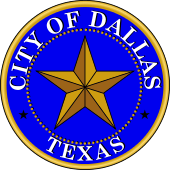Dallas Area Rapid Transit
Dallas Area Rapid Transit (DART) is a transit agency serving the Dallas–Fort Worth metroplex of Texas. It operates buses, light rail, commuter rail, and high-occupancy vehicle lanes in Dallas and twelve of its suburbs. DART was created in 1983 to replace a municipal bus system and funded expansion of the region's transit network through a sales tax levied in member cities. DART's light rail system is the longest in the United States, at over 93 miles (149.7 km), and began operation in 1996. At 95,800 weekday boardings, it is also the 6th busiest light rail system in the United States. DART operates the Trinity Railway Express between Dallas and Fort Worth, through an interlocal agreement with Trinity Metro. The agency also operates the Dallas Streetcar and provides funding for the non-profit McKinney Avenue Streetcar.
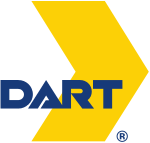 | |
 Arapaho Center Light Rail Station (Top) A DART NovaBus RTS (Bottom) | |
| Founded | 1983 |
|---|---|
| Headquarters | 1401 Pacific Avenue |
| Locale | Dallas, Texas |
| Service area | Dallas and 12 nearby suburbs[1] |
| Service type | Bus, light rail, commuter rail, modern streetcar |
| Routes | 161 bus 20 FLEX / shuttle 4 light rail 1 commuter rail 1 modern streetcar[2] |
| Stops | 14,000[3] |
| Hubs | 14 (transfer centers)[2] |
| Stations | 64 (light rail) 10 (commuter rail) 6 (streetcar) |
| Fleet | 649 (bus) 163 (light rail)[3] |
| Daily ridership | 243,600 (weekday)[2] |
| Annual ridership | 70.5 million[2] |
| Fuel type | DC Electric, Liquefied Natural Gas, Diesel |
| Chief executive | Gary Thomas |
| Website | DART |
Ridership
Average daily ridership for DART has been in the vicinity of 200,000 riders per day over the last couple decades. In the 1st quarter of 1998, DART's weekday ridership averaged 211,000 riders per day system-wide.[4] Ridership has risen and fallen since then; total ridership, including Trinity Railway Express ridership, has been as high as 248,500 average weekday riders in the 3rd quarter of 2008,[5] and as low as 194,700 average weekday riders in the 1st quarter of 2010.[6] However, after a year-long study in 2012 that counted passenger counts through both the existing manual method and a new automated counting system, DART concluded it has been underreporting rail ridership by more than 15 percent each year.[7] In the 4th quarter of 2012, DART reported an average weekday ridership of 252,900.[8] In the fourth quarter of 2014, DART reported total ridership had declined to 233,900 weekday riders.
DART reported the following ridership numbers in the 4th quarter of 2012:[8]
- Bus: 136,500 average weekday riders
- DART Light Rail: 103,100 average weekday riders
- DART TRE: 7,300 average weekday riders
- On-Call: 2,000 average weekday riders
- Vanpool: 4,000 average weekday riders
4th quarter of 2014 ridership numbers:
- Bus: 126,300 average weekday riders
- DART Light Rail: 101,800 average weekday riders (down from 2012 in spite of having added trackage and stations to the system)
- DART TRE: 8,200 average weekday riders
- On-Call: 2,600 average weekday riders
- Vanpool: 3,200 average weekday riders
4th quarter of 2019 ridership numbers:[9]
- Bus: 124,200 average weekday riders
- DART Light Rail: 92,000 average weekday riders
- DART TRE: 7,200 average weekday riders
- On-Call: 2,100 average weekday riders
- Vanpool: 1,600 average weekday riders
History
Precursor agencies

The Dallas Transit System (DTS) was a public transit service operated by the city of Dallas, from 1964 to 1983. DTS was formed by the consolidation of various privately owned transit companies and streetcar lines. Prior to DTS, the company was formerly known as the Dallas Railway and Terminal Company when Dallas had an extensive streetcar system that spanned from Oak Cliff to North Dallas. The name was changed shortly after the last streetcar ran in January 1956. DART formally took over operations of the DTS in 1988.
In 2000, DART employees restored a 1966 DTS bus to its original state.[10]
Creation of DART
DART was created on August 13, 1983 as a regional replacement for the DTS (Although the name "Dallas Area Rapid Transit" was intended to reflect the new agency's coverage of the greater Dallas-Fort Worth Metroplex, its acronym DART almost immediately evoked comparisons to San Francisco's Bay Area Rapid Transit system, known as BART). Citizens of 15 area cities had voted to levy a 1% sales tax to join the system by the time it began transit services in 1984 (though formal acquisition of the Dallas Transit System wouldn't be complete until 1988).[11][12]
In 1985, member cities Carrollton and Farmers Branch held elections to pull out of DART, though the measures failed. But shifting suburban politics and a loss of confidence in DART management after voters declined to support DART's measure to incur long term debt in 1988 led to seven more pullout votes, two of which (Flower Mound and Coppell) were successful. Just one suburb joined DART — the tiny community of Buckingham, which was later annexed by DART member city Richardson.
Financial scandal
In December 2007, DART revealed it was facing a $1 billion shortfall in funds earmarked for the Blue Line rail service to Rowlett and Orange Line service to Irving, and DFW Airport. In January 2008, DART announced it would divert monies from rail lines being built in Dallas. When Dallas officials protested, DART president and executive director Gary Thomas—who had known about the shortfall for at least eight months—announced the agency would borrow more money.
In late January 2008, DART Board chair Lynn Flint Shaw, who was also treasurer of Dallas Mayor Tom Leppert's "Friends of Tom Leppert" fund-raising committee, resigned from her DART post. In February, she surrendered to the police on charges of forgery. On March 10, Shaw and her husband, political analyst Rufus Shaw, were found dead in their home in what turned out to be a murder suicide.[13][14]
2016 shooting
On July 7, 2016, one DART officer was among several people shot in a mass shooting targeting police officers providing security at a Black Lives Matter protest.[15][16] One of the officers, identified as seven-year veteran Brent Thompson, died from his injuries and became the first DART officer to be killed in the line of duty since the department's inception.[15][17]
DART Light Rail

The DART light rail system comprises 93 miles (149.7 km) between its four lines — the Red Line, the Blue Line, the Orange Line and the Green Line. According to NCTCOG transit statistics, DART's light rail system had a daily ridership of 109,511 average trips per weekday in October 2012. The system uses light rail trains manufactured by Kinki Sharyo, with all trains being converted to "Super" LRVs (SLRVs) which feature level boarding (especially convenient for strollers and wheelchairs) and higher passenger capacity.[18] All 163 of DART's light rail vehicles have been converted and are now SLRVs.[19]
Before the 1983 election, DART had a plan for 160 miles (257.5 km) of rail. After the election, the plan was pared down to 147 miles (236.6 km) when Duncanville, Grand Prairie and Mesquite, which would have had rail lines, opted to not join the agency. DART chose light rail transit as its primary mode of rail transportation in 1984. The plan was pared down again to 93 miles (149.7 km) before the 1988 bond vote. After the vote, the agency again pared the regional rail system to 84 miles (135.2 km); 66 miles (106.2 km) of light rail and 18 miles (29 km) of commuter rail. As of August 2014, DART boasts four lines, and the extension of the Orange line to DFW airport is complete.
The following lines are active:
- Red Line (Opened in 1996, completed in its current state in 2002)
- Blue Line (Opened in 1996, completed in its current state in 2016)
- Green Line (Opened in 2009, completed in its current state in 2010)
- Orange Line (Opened in 2012, completed in its current state in 2014)[20]
On December 18, 2000, DART opened the first public subway station in Texas. Cityplace station is served by the Red, Blue, and Orange Lines.[21]
Streetcars
McKinney Avenue Transit Authority
DART also assists in the operation of the M-line Trolley, with a joint operating subsidy given to the McKinney Avenue Transit Authority along with the Uptown Improvement District.
Dallas Streetcar
In May 2013,[22][23] DART began construction on a 1.6-mile (2.6 km) streetcar line which will operate between downtown Dallas and Oak Cliff by way of the Houston Street Viaduct.[24] Phase one of the streetcar line, running between Union Station in Dallas and Methodist Dallas Medical Center in Oak Cliff, opened on April 13, 2015.[25] The line was expanded to its current length in August 2016 with the addition of the 6th Street and Bishop Arts stops.
Commuter rail
Trinity Railway Express
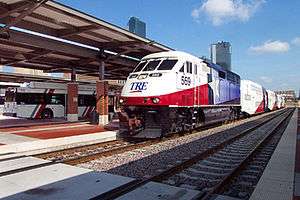
The Trinity Railway Express (TRE) commuter rail line connects downtown Dallas with downtown Fort Worth. The TRE, created in 1996 by an interlocal agreement between DART and Trinity Metro, connected the cities' centers by rail for the first time since the 1930s, excluding Amtrak's Texas Eagle.
The TRE commuter line has an average weekday ridership of 7,300 passengers per day[8] and is the fifteenth most-ridden commuter rail system in the country. In 2012, the TRE carried a total of 2.3 million passengers.[26]
DCTA A-train
The Denton County Transportation Authority (DCTA) built its A-train commuter rail service in partnership with DART and the TRE. The DCTA leases the right-of-way for its 21 miles (34 km) commuter line from DART, and coordinates with DART to provide connecting service between the A-train and DART's Green Line. The DCTA also leased Budd diesel rail cars from the TRE for its initial service.[27] The A-train operates between downtown Denton and Trinity Mills station, where a transfer to the Green Line is available. Through its partnerships with DART and TRE, DCTA sells "Regional" fare passes which include access to DART and TRE service.[28]
Buses
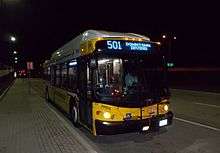
In 2015, DART operates 121 fixed-regular bus routes and several circular and shuttle routes. There are 27 local routes, which serve downtown Dallas. Some locals link the suburbs with downtown Dallas. There are 9 express routes which ferry passengers between two areas with limited or no stops in between. These use HOV lanes on freeways when possible. There are 15 suburban routes, which link the suburban neighborhoods of DART to transit centers. DART has 20 crosstown routes which run through Dallas and its suburbs, but not downtown. The final fixed route category are the 50 rail-feeder routes that start and/or end at rail stations.
Most trips in the DART system are carried by the bus system. In the 1st quarter of 2010, DART had 125,500 bus trips per average weekday out of a total of 194,700 trips.[6]
DART numbers its bus routes according to the type of route:
- Local routes, serving downtown: 1-183 (routes numbered in the 100's operate via freeways for a portion of the route approaching Downtown Dallas)
- Express routes, limited-stop service using larger vehicles with reclining seats: 200s
- "Suburban" routes, local routes originating at a transit center: 300s
- Crosstown routes, local routes connecting widely separated areas: 400s
- Rail feeder routes, local routes originating at a rail station: 500s
In addition to the above regular fixed routes, DART will also contract with its neighbors or businesses and run circulators, like the Southern Methodist University or NorthPark Center circulators or shuttles for Texas Instruments or UT Southwestern Medical Center. The circulator routes are given number in the 700 range, while the shuttles are listed in the 800s.
DART runs its bus system similar to the hub and spoke model some airlines use. DART has several bus-only facilities, which include transit centers, transfer centers, transfer locations, and Park & Rides.
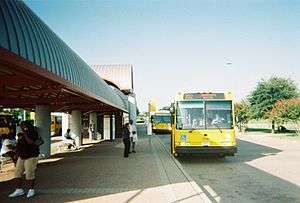
DART has 7 transit centers, which are:
- Addison Transit Center in Addison, a future rail station on the Cotton Belt in the 2030 plan
- J.B. Jackson Transit Center in Dallas
- Lake Ray Hubbard Transit Center in Garland
- Downtown Irving/Heritage Crossing Station in Irving
- North Irving Transit Center in Irving
- Red Bird Transit Center in Dallas
- South Garland Transit Center in Garland
- Jack Hatchell Transit Center in Plano
The DART bus system has five transfer locations/centers:
- Bernal/Singleton Transfer Location in Dallas, a possible future rail station on the west rail line toward Grand Prairie in DART's 2030 plan
- Cockrell Hill Transfer Location in Cockrell Hill
- East Transfer Center in downtown Dallas
- Malcolm X Boulevard Transfer Location in South Dallas
- West Transfer Center in downtown Dallas
Finally, DART has two Park and Ride locations:
- Glenn Heights Park and Ride in Glenn Heights
- Northwest Plano Park and Ride off the Dallas North Tollway just north of Spring Creek Parkway in Plano
In addition, to make transfers easier, most rail stations are hubs for DART buses.
On October 2012, DART introduced a new fleet of 14 to 17-passenger buses for its on-call & Flex services, and beginning on October 22, some select bus routes that are less-traveled.[29] Beginning in 2013, DART would replace most of bus fleet with NABI 40LFW buses running off CNG fuel. Voted unanimously, by state government to rapidly revise to a clean-air fleet over their existing diesel buses.
On-Call service
Prior to the bus and rail changes on October 6, 2003, DART has launched its premium on-call shuttle service to replace many low-productive DART bus routes. It was first opened in some North Dallas and Plano neighborhoods and, in late 2005, it expanded to Glenn Heights in Northern Ellis County. DART On-Call operates on weekdays only (except on holidays).[30]
The On-Call service serves north central Plano, eastern Rowlett, Farmers Branch, North Dallas, Lakewood, Richardson, Lake Highlands, and Glenn Heights.
Flex service
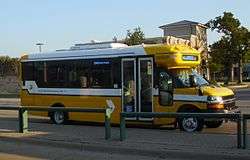
DART introduced a new service into its system called a "Flex" service in 2008. It is similar to DART On-Call but combines the advantages of a fixed bus route along with curbside pickup. It uses a local fare on stops at fixed routes and/or a premium fare on curbside pickups and dropoffs within the Flex zone if time permits. Customers in those areas who desire a pickup at a specific location may do so by calling DART 1 h before their destination time or at stop.[31]
The Flex service serves the following areas:
- East Plano (replaced routes 570, 760, and DART On-Call East Plano.)
- Garland/Rowlett (replaced route 557.)
- Pleasant Grove (replaced route 842.)
- South Irving (Clockwise/Counter-clockwise. Replaced portions of routes 302 & 306)
- South Plano (to replace busiest portions of Telecomm Corridor Flex Service during peak hours.)
- Telecomm Corridor (Bi-directional, weekday rush hours only) (replaced portions of route 316)
![]()
Fares
Up to two children under 5 travel free if accompanied by a fare-paying rider. GoPass can be used for all of the fare types below.

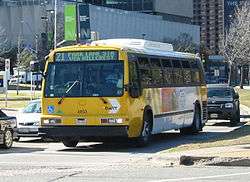
| Service Type | Fare | |
|---|---|---|
| DART Local Single Ride (Bus Only) | $2.5 | |
| DART Local AM/PM Pass | $3 | |
| DART Local Mid-Day Pass (9:30 AM – 2:30 PM) | $2 | |
| DART Local 24-Hour Pass | $6 | |
| DART Local Monthly Pass | $96 | |
| DART Annual Local Pass | $960 | |
| Regional 24-Hour Pass | $12 | |
| Regional Monthly Pass | $192 | |
| Regional Annual Pass | $1,920 | |
| Reduced*/High School Single Ride (Bus Only)** | $1.25 | |
| Reduced*/High School AM/PM Pass** | $1.5 | |
| Reduced*/High School 24-Hour Pass** | $3 | |
| Reduced*/High School Monthly Pass** | $48 | |
Single Ride: One-way trip, cash-only fare on buses only. No pass issued.
Local: DART buses and trains; Trinity Railway Express service between Union Station and CentrePort/DFW Airport Station; GoLink, DART On-Call and FLEX service.
Regional: DART buses and trains; all Trinity Railway Express service; Trinity Metro in Fort Worth; and DCTA in Denton, including the A-train.
* Reduced fares are applicable on bus and rail for seniors and non-paratransit riders with disabilities; children ages 5–14; Medicare card holders; designated bus circulators, all of which are charged at the local rate.
** Reduced high school fare is valid Monday through Sunday for students with valid photo ID from a high school within the DART service area.
Fares effective: August 18, 2018
Member cities
In addition to the cities that voted to join DART at its creation, the legislation that created DART specifies any city adjoining Dallas may join the agency. In addition, any city that adjoins a DART member city becomes eligible to join. Member cities fund DART with a 1% sales tax. This levy prevents some cities from joining, due to Texas laws that cap the total sales tax that may be charged.
In 2003, the Texas Legislature enacted new legislation enabling countywide transit districts in areas adjacent to major metropolitan areas (such as the Denton County Transportation Authority), but DART's membership rules were not affected.
List of DART member cities
In addition to the city of Dallas, the following cities are also DART members:
- Addison planned a vote to withdraw from DART but cancelled the measure in January 1990.
- Carrollton voted to remain a DART member in January 1985 by a 69–31 percent margin, again voted in August 1989 to remain a member, and yet again voted to remain a member in August 1996 by a 77–23 percent margin.
- Farmers Branch voted to remain a DART member in January 1985 by a 61–39 percent margin, and again voted in November 1989 to remain a member.
- Garland voted to remain a DART member in November 1989 and again in January 1996 (the latter by a 2–1 margin).
- Glenn Heights is the only suburb in the southern section of the Dallas area that is a DART member (although Cockrell Hill is also in the southern section, it is technically an enclave of Dallas).
- Irving voted to remain a DART member in August 1989, and again voted to remain a member in August 1996 by a 57–43 percent margin.
- Plano voted to remain a DART member in August 1989, and again voted to remain a member in August 1996 by a 77–23 percent margin.
- Richardson annexed the former city of Buckingham in 1996; Buckingham was (and remains) the only city to join DART subsequent to the 1983 charter election. Also, Buckingham planned a withdrawal vote but cancelled it in July 1989.
- Rowlett voted to remain a DART member in August 1989, and again voted to remain a member in August 1996 by a 67–33 percent margin.
All the suburbs listed joined DART as charter members in 1983 (except for Buckingham, no other cities have joined DART subsequent to 1983, and two cities later withdrew as shown below). Glenn Heights is the only suburb which, had it not joined DART in 1983, would be ineligible for membership today, as it does not border either Dallas or another DART member city.
Original cities that declined DART
The cities of Duncanville, Grand Prairie, Lancaster, Mesquite, The Colony, and Wilmer had a proposal to join DART on the ballot in 1983, but voters declined to join. The Colony is the only suburb in the northern portion of Dallas which declined to join DART, yet is still eligible to join, as it borders Carrollton, a DART member. (The Colony is also eligible to join DCTA, as it is in Denton County.) Wilmer is no longer eligible to join DART, as it is not bordered by a DART member city.
Former DART member cities
The cities of Coppell and Flower Mound were original members of DART. However, after voters in the DART service area rejected a 1988 ballot measure plan which would have allowed DART to take on long-term debt, the cities placed measures on the 1989 ballot to withdraw from DART, and the voters approved the measures.
Coppell remains eligible to rejoin DART, as it borders three DART member cities (Dallas, Irving, and Carrollton).
Flower Mound is no longer eligible to rejoin DART as it does not border a DART member city. Flower Mound voters were asked to join DCTA in 2003 but rejected that measure as well.
Eligible cities that are not members of DART
These cities are eligible to join DART as they are adjacent to either Dallas or another DART member city, but have not chosen or are unable to levy the required 1% sales tax required for membership and regular service. However, DART can establish service to non-member cities under certain conditions. In addition to the Trinity Railway Express interlocal agreements, DART serves destinations like Eastfield College, which is within the city limits of non-DART member Mesquite.
| Eligible City | Bordering DART Member City/Cities | Notes |
|---|---|---|
| Allen | Plano | |
| Arlington | Irving | Formerly operated Metro Arlington Xpress from 2013-2017. |
| Balch Springs | Dallas | operated by STAR Transit |
| Cedar Hill | Dallas, Glenn Heights | |
| Coppell | Carrollton, Dallas, Irving | 1983 charter member, but withdrew in 1989 |
| DeSoto | Dallas, Glenn Heights | operated by STAR Transit; Start in 2018 |
| Duncanville | Dallas | declined membership in original 1983 ballot |
| Euless | Irving | |
| Fort Worth | Irving | operated by Trinity Metro |
| Frisco | Plano | |
| Grand Prairie | Dallas, Irving | declined membership in original 1983 ballot |
| Grapevine | Irving | November 2006 ballot measure to approve a sales tax to fund commuter rail service operated by Trinity Metro passed with 75% of the vote, a 3-1 margin[32][33] |
| Heath | Dallas, Rowlett | |
| Hutchins | Dallas | May 1992 ballot measure to join DART was rejected by 50 votes |
| Lancaster | Dallas, Glenn Heights | declined membership in original 1983 ballot |
| Lewisville | Carrollton | Lewisville voters approved membership in the Denton County Transportation Authority in 2003, which levies a 1/2 cent sales tax |
| McKinney | Plano | McKinney's border with Plano takes place at the corner of Texas State Highway 121 and Farm to Market Road 2478 (Custer Road), at one of the few places in the DFW Metroplex where four cities meet |
| Mesquite | Dallas, Garland | declined membership in original 1983 ballot; operated by STAR Transit |
| Murphy | Plano, Richardson | May 1992 ballot measure to join DART was rejected by a 2–1 margin |
| Oak Leaf | Glenn Heights | |
| Ovilla | Glenn Heights | |
| Parker | Plano | |
| Red Oak | Glenn Heights | |
| Rockwall | Dallas, Rowlett | |
| Sachse | Garland, Richardson, Rowlett | |
| Seagoville | Dallas | operated by STAR Transit |
| Sunnyvale | Dallas, Garland | |
| The Colony | Carrollton, Plano | declined membership in original 1983 ballot |
Executive directors
- Maurice Carter 1982–1984
- George Bonna (Interim) 1984–1985
- Ted Tedasco 1985–1986
- John Hoeft (Interim) 1986
- Charles Anderson 1986–1992
- Tony Venturato (Interim) 1992
- Jack Evans 1992
- Victor Burke (Interim) 1993
- Roger Snoble 1993–2001
- Gary Thomas 2001–present
See also
References
- DART.org – About DART
- "Dallas Area Rapid Transit Reference Book" (PDF). Dallas Area Rapid Transit. March 2020. Retrieved May 26, 2020.
- "Facts about Dallas Area Rapid Transit (DART)". Facts about Dallas Area Rapid Transit (DART). Dallas Area Rapid Transit. Retrieved August 2, 2018.
- "PUBLIC TRANSPORTATION RIDERSHIP REPORT – First Quarter 1998" (PDF). American Public Transportation Association. Retrieved April 9, 2013.
- "PUBLIC TRANSPORTATION RIDERSHIP REPORT – Third Quarter 2008" (PDF). American Public Transportation Association. Retrieved April 9, 2013.
- "PUBLIC TRANSPORTATION RIDERSHIP REPORT – First Quarter 2010" (PDF). American Public Transportation Association. Archived from the original (PDF) on July 4, 2010. Retrieved April 9, 2013.
- "inMotion – The official newsletter of Dallas Area Rapid Transit – Spring 2013". DART. Retrieved April 9, 2013.
- "PUBLIC TRANSPORTATION RIDERSHIP REPORT – Fourth Quarter 2012" (PDF). American Public Transportation Association. Archived from the original (PDF) on May 10, 2013. Retrieved April 9, 2013.
- "PUBLIC TRANSPORTATION REPORT - Fourther Quarter 2019" (PDF). American Transportation Association. Archived from the original (PDF) on May 23, 2020. Retrieved May 26, 2020.
- DART Breathes Life into Retired Dallas Transit System Bus DART.org – Site Information
- Dallas Area Rapid Transit Reference Book (Version 3.0) (PDF). Dallas Area Rapid Transit. April 2012.
- Dallas Area Rapid Transit Disadvantaged Business Enterprise Final Compliance Review Report (PDF). Federal Transit Administration. September 2012.
- Ex-DART Chair Apparent Victim In Murder-Suicide Archived February 18, 2010, at the Wayback Machine Retrieved November 10, 2009, from cbs11tv.com Archived October 21, 2010, at the Wayback Machine
- Prominent Dallas Couple May Have Had Suicide Pact Archived February 18, 2010, at the Wayback Machine Retrieved November 10, 2009, from cbs11tv.com Archived October 21, 2010, at the Wayback Machine
- McGee, Patrick; Fernandez, Manny; Bromwich, Jonah Engel (July 7, 2016). "Snipers Kill 5 Dallas Officers at Protest Against Police Shootings". The New York Times. ISSN 0362-4331. Retrieved July 7, 2016.
- Hennessy-Fiske, Molly; Wilber, Del Quentin; Pearce, Matt (July 8, 2016). "'Loner' Dallas gunman had bomb materials and kept journal of combat tactics". The Los Angeles Times. Retrieved July 8, 2016.
- "What we know so far about deadly ambush in downtown Dallas". The Dallas Morning News. July 7, 2016. Retrieved July 8, 2016.
- "DART.org – Super Light Rail Vehicles (SLRV) Facts". DART.org. October 29, 2010. Retrieved April 9, 2013.
- "DART Rail Facts". DART.org. Retrieved April 9, 2013.
- "DFW Airport Station triggers several DART train, bus changes". dallasnews.com. July 28, 2014. Archived from the original on August 13, 2014. Retrieved August 13, 2014.
- "DART History: 2000". Dallas Area Rapid Transit. Retrieved December 4, 2010.
- Tramways & Urban Transit magazine, July 2013, p. 311.
- "Ground Breaking for Dallas Streetcar Project". Passenger Transport. American Public Transportation Association. May 17, 2013. Retrieved January 10, 2015.
- "Fact Sheet: Downtown Dallas-Oak Cliff Streetcar" (PDF). Archived from the original (PDF) on November 3, 2013. Retrieved May 3, 2014.
- Appleton, Roy (April 13, 2015). "Dallas' new streetcar begins service between downtown, Oak Cliff". The Dallas Morning News Transportation Blog. Archived from the original on April 19, 2015. Retrieved April 22, 2015.
- "About Trinity Railway Express". Archived from the original on February 4, 2012. Retrieved April 9, 2013.
- "A-Train Breaks the Mold". Metro Magazine. March 2012. Archived from the original on June 20, 2013. Retrieved March 4, 2013.
- "Fare Information". DCTA.net. Archived from the original on May 29, 2013. Retrieved April 9, 2013.
- New, Smaller Buses Make Neighborhood Debut During October – DART (released October 22, 2012)
- DART News Release Regarding Bus Changes on October 6, 2003 Retrieved September 22, 2003.
- DART Service Change Information – Section I: New Flex Service
- "USA: Huge Net Gain for Public Transport in November 2006 Vote". Light Rail Now. November 2006. Retrieved January 10, 2015.
- "Public Transportation – TEX Rail Commuter Rail". City of Grapevine Texas. Retrieved January 10, 2015.
External links
| Wikimedia Commons has media related to Dallas Area Rapid Transit. |
